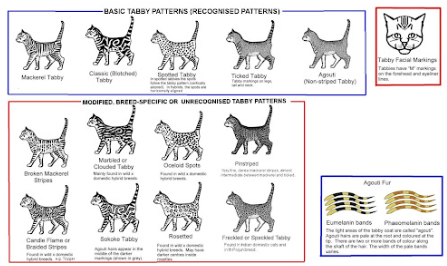Cats, with their sleek bodies and enigmatic personalities, have captivated humans for millennia. One of the most fascinating aspects of these feline companions is their unique markings. From the classic tabby to the exotic bicolor, each marking pattern tells a story about a cat’s lineage, temperament, and even its health.
This comprehensive guide will delve into the world of cat markings, exploring their history, genetics, and the various names associated with them. We will examine the different types of markings, their characteristics, and how they are formed. Additionally, we will discuss the cultural significance of cat markings in various societies and the impact of selective breeding on the development of new patterns.
By the end of this article, you will have a deep understanding of cat markings names, enabling you to appreciate the beauty and diversity of these amazing creatures.

Part I: The Genetics of Cat Markings
1. The Role of Melanocytes
- The role of melanocytes in determining coat color and patterns
- The genetic factors that influence melanocyte activity
2. The Agouti Gene
- The agouti gene and its effect on coat color and patterns
- The different alleles of the agouti gene and their corresponding markings
3. The Tabby Gene
- The tabby gene and its role in creating tabby patterns
- The different types of tabby patterns (mackerel, classic, ticked) and their genetic basis
4. The White Spotting Gene
- The white spotting gene and its influence on coat color and patterns
- The different levels of white spotting and their genetic inheritance
5. The Dilute Gene
- The dilute gene and its effect on coat color
- The difference between full color, dilute, and dilute-calico cats
Part II: The Different Types of Cat Markings
1. Tabby Markings
- Mackerel tabby: Characteristics, appearance, and genetic basis
- Classic tabby: Characteristics, appearance, and genetic basis
- Ticked tabby: Characteristics, appearance, and genetic basis
- Abyssinian tabby: Characteristics, appearance, and genetic basis
- Egyptian Mau tabby: Characteristics, appearance, and genetic basis
2. Solid-Colored Markings
- Black: Characteristics, appearance, and genetic basis
- White: Characteristics, appearance, and genetic basis
- Blue: Characteristics, appearance, and genetic basis
- Cream: Characteristics, appearance, and genetic basis
- Red: Characteristics, appearance, and genetic basis
3. Bicolor Markings
- Harlequin: Characteristics, appearance, and genetic basis
- Tuxedo: Characteristics, appearance, and genetic basis
- Van: Characteristics, appearance, and genetic basis
- Mittens: Characteristics, appearance, and genetic basis
4. Tortoiseshell Markings
- Tortoiseshell: Characteristics, appearance, and genetic basis
- Calico: Characteristics, appearance, and genetic basis
5. Other Markings
- Lynx point: Characteristics, appearance, and genetic basis
- Siamese point: Characteristics, appearance, and genetic basis
- Colorpoint: Characteristics, appearance, and genetic basis
- Shaded: Characteristics, appearance, and genetic basis
- Smoke: Characteristics, appearance, and genetic basis
Part III: The Cultural Significance of Cat Markings
1. Cat Markings in Ancient Egypt
- The symbolism of cat markings in ancient Egyptian mythology and religion
- The role of cats with specific markings in Egyptian culture
2. Cat Markings in Japanese Folklore
- The significance of different cat markings in Japanese folklore and superstitions
- The connection between cat markings and luck or misfortune
3. Cat Markings in European Mythology
- The symbolism of cat markings in European folklore and mythology
- The association of certain cat markings with witchcraft or magic
Part IV: The Impact of Selective Breeding on Cat Markings
1. The Development of New Markings
- The role of selective breeding in creating new cat breeds with unique markings
- Examples of breeds developed through selective breeding (e.g., Bengal, Ragdoll, Sphynx)
2. The Preservation of Rare Markings
- The importance of preserving rare or endangered cat markings
- Conservation efforts to protect genetic diversity
Conclusion
Cat markings are a fascinating aspect of feline genetics and culture. From the classic tabby to the exotic bicolor, each pattern tells a unique story about a cat’s lineage, temperament, and place in the world. By understanding the genetics behind cat markings and their cultural significance, we can appreciate the beauty and diversity of these amazing creatures.
FAQs
- What is the difference between a tabby and a tiger?
- Can a cat change its markings as it ages?
- Are there any health implications associated with certain cat markings?
- How can I determine the breed of a cat based on its markings?
- What is the rarest cat marking?
Additional Resources
- The Cat Fanciers’ Association: https://cfa.org/about-cfa/
- The International Cat Association: https://tica.org/
- World Cat Federation: https://wcf.de/en/
- Cat Genetics and Breeding: https://cfa.org/kids/breeds-and-colors/cfa-breeds/
- The Biology of Cats: https://www.alleycat.org/resources/biology-and-behavior-of-the-cat/






